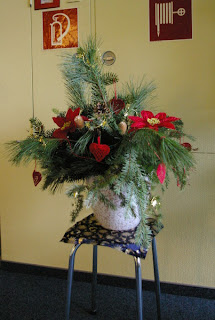It was Christmas everywhere:
Schatz' Dad conveniently lives in a highrise built on top of a parking garage and shopping mall, which comes in very handy when the weather is bad. It is also great because it is only yards from the River Weser and offers a superb view over the waterway.
On Christmas Day, we had Labskaus for lunch. I have loved this dish ever since Karin made it for me more than 30 years ago. Her recipe - from 30 km south of Bremen - was slightly different from the one Schatz makes - from 50 km north of Bremen - but the dish is traditional Northern German although it can also be found in parts of Scandinavia.
Labskaus is considered a typical dish for long sea voyages, and though it doesn't look like much to some, the combination of salted beef (or corned beef), potatoes, onions, red beets, gurkins, sour herrings, fried egg, salt and pepper is not only savoury but also refreshing in its own way. Onions, potatoes, and beets also are good against scurvy.
After lunch, we went for a walk. First down into the shopping mall. Where it was Christmas.
 Christmas in the central plaza - or:
Christmas in the central plaza - or:"Süßer die Kassen nie klingeln..." (caption by Schatz)
But the shops were closed, including this coffee house which tries to benefit from some loopholes in the anti-smoking law for pubs and restaurants. This owner thinks he can solve the problem by having customers smoke locally...
Eventually, we walked along the dyke of the River Weser. It was cold and grey but quite a few people were out for a stroll.
The original semaphore was located about 30 km downriver from here on the quay of a lighthouse, and used from 1893 to 1973 to indicate to mariners both wind direction and speed for the islands of Borkum and Heligoland. In the above setup, winds are Eastern for both locations and 3 beaufort for Borkum and 6 beaufort for Heligoland respectively.
We walked on and finally reached our destination, the "Deutsches Auswandererhaus" (German Emigration Center).
Its main focus is on Bremerhaven as the major port for emigration from (or via) Germany from 183o to 1974 for Germans but also Eastern and South-Eastern Europeans. From these quays, more than 7 million people left Europe for a new life.
Even before actually entering the exhibition, the museum tries to create the right kind of atmosphere with transparent boxes of what things people might have taken aboard throughout the decades of emigration, from the late 19th century right up to the 1970's. You then enter a room that takes you a step further, with images and sounds, and then releases you up some stairs onto the quay.
Once you have climbed the gangway yourself, you pass holds filled with luggage on your way to the various cabins and berths.
By now, people were actually not just going one way into a hopefully better life but were traveling back and forth between the US and Europe, for example, for business and for holidays.
Throughout the exhibition, you are accompanied by visual and audio effects - great when you are ablebodied but somewhat of a nuisance when you have some hearing problems. But there are also plenty of items from the respective eras to take you right back in time, as well as some models occasionally.
Also well done is the room of the 5 million - drawer upon drawer, images, names, audio sources about famous and not so famous emigrants. Actually, your entrance ticket carries the name of an emigrant and you can follow their tales throughout the exhibition, not just in this room.
Whereas in the 19th and first half of the 20th century, the majority of emigrants left Germany for the New World - mainly the Americas - things were a bit different in 2006:
But people not only left Europe via Bremerhaven, some also arrived here, like this young man on October 1st, 1958:
 The King and his Court
The King and his CourtBy the time we left the museum, Elvis had left the building, too.
Outside, it was dark by now - which meant that we got to see the changing lights on the globe on the upper floor of the museum in a variety of colours (see the full image for a better view).
There are more pictures to come, notably from the various cameras of Schatz. Here is one of the man himself:
PS: Just to pre-empt any such comment - Labskaus never was the cause of emigration, but only of re-migration!


















1 comment:
I'd like to have a look around that museum one of these days.
The Labskaus looks like an 'aangeklede uitsmijter' with beets, only with less eggs...
Post a Comment